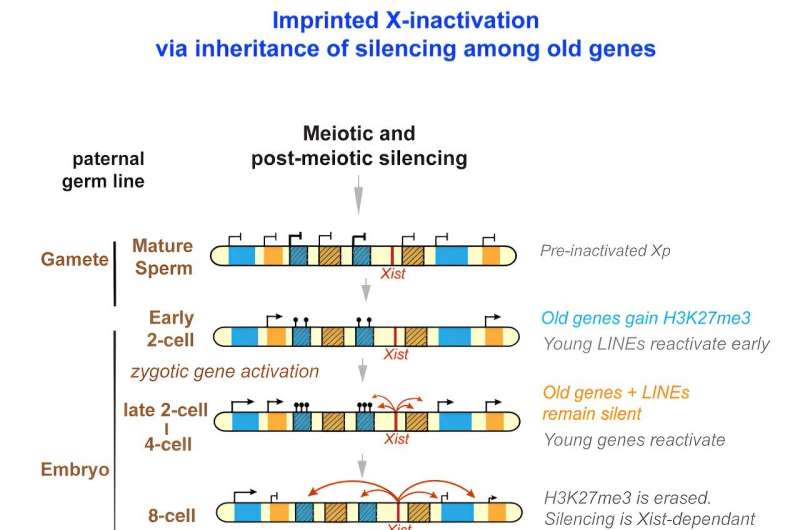This article has been reviewed according to Science X's editorial process and policies. Editors have highlighted the following attributes while ensuring the content's credibility:
fact-checked
trusted source
proofread
New insights into the silencing of X chromosome genes passed on from fathers to daughters

Daughters inherit two X chromosomes (one from the mother and one from the father), while sons inherent an X chromosome only from the mother. In new research published in Molecular Cell, investigators at Massachusetts General Hospital (MGH) discovered that a large part of the X chromosome that a father passes on to his daughter is silent, even before fertilization.
This may be a mechanism to balance X-linked gene activity between the sexes during early embryo development, as well as during evolution as the Y-chromosome (which started off equal to the X) lost more and more of its genetic material.
For the study, scientists analyzed the pattern and timing of gene expression in mouse embryos. They found that some genes on the X chromosome passed on from the father become newly inactivated during female embryo development, as previous research has shown.
Others, however, were inherited from the father in a pre-suppressed state, a finding that had not been demonstrated before, although the idea was long-postulated. Interestingly, these pre-suppressed genes tended to be the oldest in terms of their evolutionary age on the X chromosome.
"We believe that this is an ancient mechanism whereby the paternal germline ensures that sons and daughters get the same 'dose' of the X chromosome during embryogenesis. Otherwise, daughters would always have twice as many X-genes as sons, which would put male embryos at a disadvantage," explains senior author Jeannie T. Lee, MD, Ph.D., the Phillip A. Sharp Endowed Chair in Molecular Biology at MGH and a Professor of Genetics at Harvard Medical School.
"These pre-silenced genes need to be precisely controlled in embryos, and this mechanism also avoids overdosage of X-genes in daughters," adds first author and postdoctoral fellow, Chunyao Wei, Ph.D.
It turns out that balancing sex chromosomes is even more complex, as the maternal X chromosome has to be turned up in expression in both male and female offspring to keep balance with the rest of the genome. Lee and her colleagues also found that hyper-activation of genes on the maternal X chromosome was timed with silencing of genes on the paternal X chromosome during female embryo development.
Therefore, when genes on the paternal X chromosome were expressed, they were moderately expressed on the maternal X chromosome, but when genes on the paternal chromosome were silenced, they were highly expressed on the maternal X chromosome. "This fine balancing act ensures that other chromosomes, which are always present in two copies, do not overpower the X chromosome," says Lee.
More information: Chunyao Wei et al, Imprinted X chromosome inactivation at the gamete-to-embryo transition, Molecular Cell (2024). DOI: 10.1016/j.molcel.2024.02.013


















